
BIX ARTICLE
Can Investors Build an ESG Fixed Income Portfolio Without Sacrificing Returns?
May 03, 2021
|
10 min read
Featured Posts
Social Bonds Illustrative Use-Of-Proceeds Case Studies Coronavirus
Jul 06, 2020
|
2 min read
Sustainable Banking Network (SBN) Creating Green Bond Markets
Jul 06, 2020
|
2 min read
Why is Inflation Making a Big Comeback After Being Absent for Decades in the U.S.?
Mar 24, 2022
|
7 min read
SC issues Corporate Governance Strategic Priorities 2021-2023
Mar 29, 2022
|
3 min read
- In 2020, sustainable fixed income funds beat their traditional peers in both risk and return performance metrics.
- However, in the longer term, results are inconclusive, likely a result of stricter investment mandates and a smaller variety of investment offerings.
- With a likely record ESG bond issuance in 2021, this should go some way to alleviating the latter issue.
- At present, we believe the optimal approach is to incorporate some ESG positive funds to supplement your existing portfolio, and investors can begin by considering some of the funds recommended below.
Read: ESG – Latest developments in a rapidly growing investment theme
Well, yes (to some extent)
In an article published last year, we looked into multiple studies to see if sustainable investing brings about benefits and higher returns to a portfolio. The conclusion drawn then, was that firms with high ESG scores tend to deliver higher returns, perform better during downturns, and show better risk characteristics. However, these firms also tend to be larger firms, which are of inherently higher quality, which could mean that the lower volatility and higher returns may not be a result of the ESG factor.
Read: ESG may be good for the world, but is it good for your portfolio?
A more recent study1 conducted by Morgan Stanley came to similar conclusions. In 2020, sustainable fixed income funds beat their non-sustainable counterparts by 0.9%, and had lower downside deviation by 0.4%.
However, after taking a step back and looking at a longer horizon, results are inconclusive. From both risk and return characteristics (Chart 1 & 2), there has not been a clear and consistent outperformer historically.
Chart 1: Historical Performance of Sustainable vs Traditional Fixed Income Funds
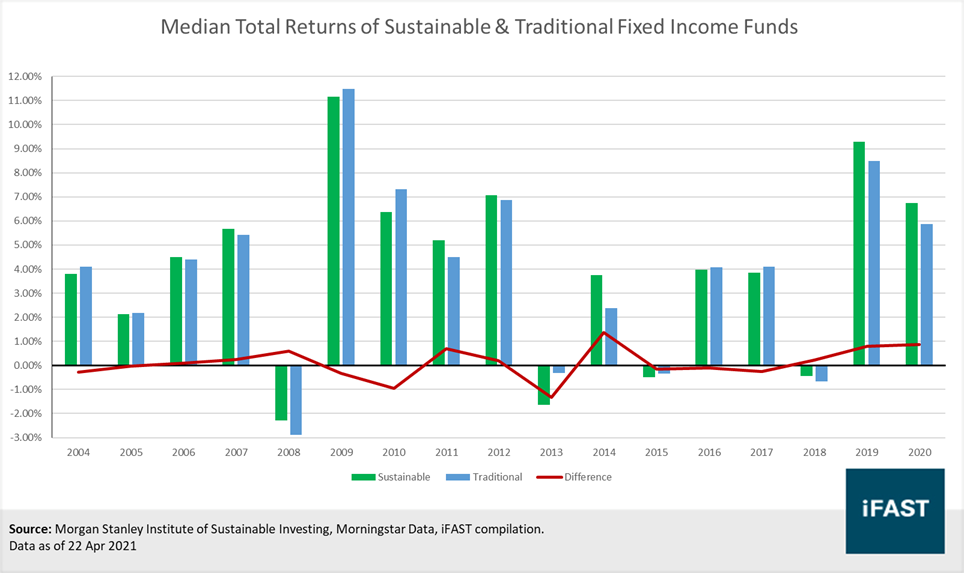
Chart 2: Historical Downside Deviation of Sustainable vs Traditional Fixed Income Funds
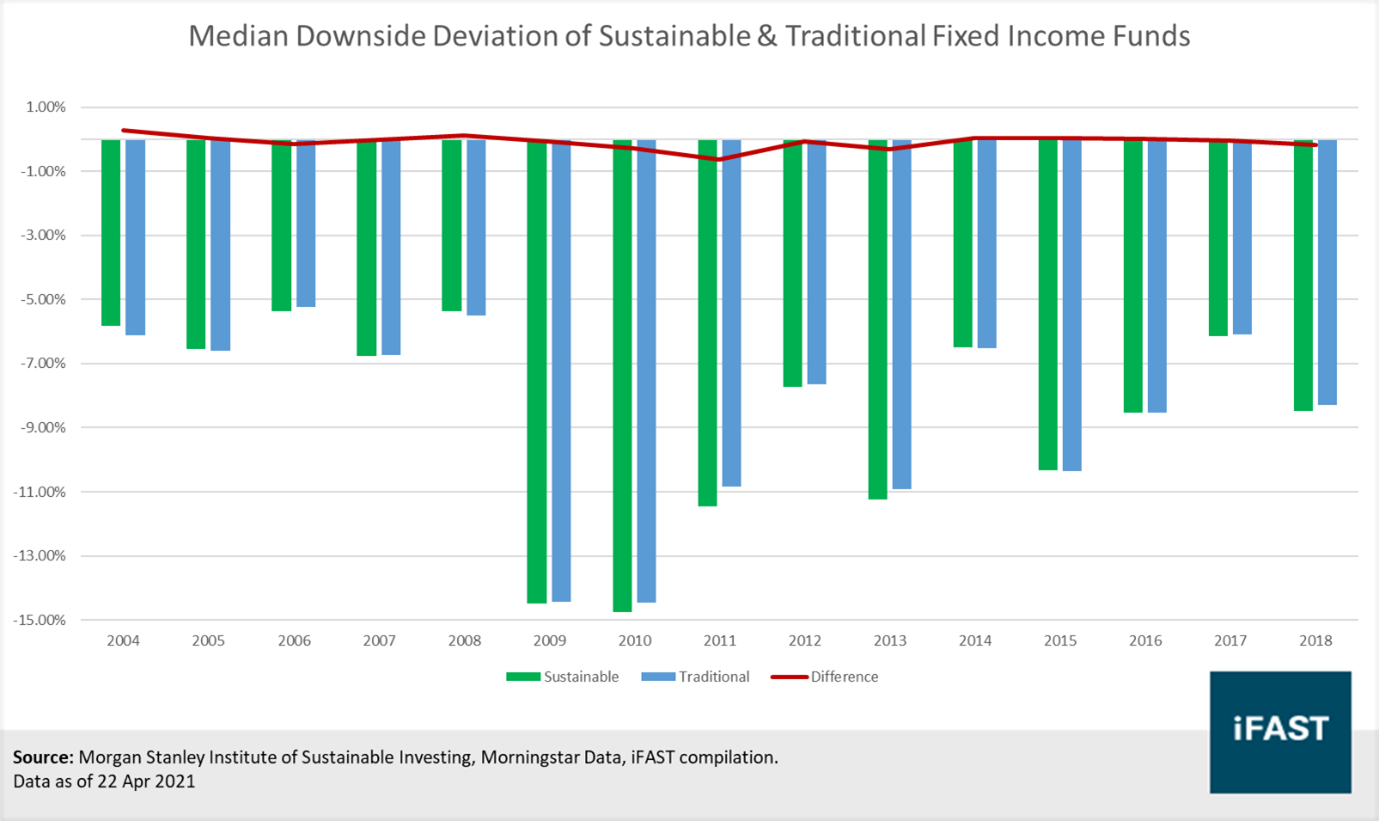
A quick glance under the hood reveals why that is the case. The ESG investment universe, particularly for fixed income, is still incredibly limited by the variety of offerings. In a report2 published by CAMRADATA, an analytics firm, fund managers highlighted a lack of variety in ESG fixed income products, specifically in duration. Combined with a stricter investment mandate, this could have likely affected the ability of fund managers to manage the fund’s duration effectively, leading to poorer performance during periods of rising yields. This is also a concern given the current economic climate in the US, with rising yields looming as economic recovery and inflation picks up steam.
However, there are positive developments in this space that should help to ease some of the aforementioned headwinds. ESG bonds had a record issuance in 2020, fuelled by the increase in social bonds issued to combat the fallout caused by the pandemic. Social bonds finance projects that aim to address or mitigate specific social issues or achieve positive social outcomes. In 2020, the European Commission increased their social bond issuance to record levels to address pandemic related issues, mainly to support employment generation and increase provision of healthcare equipment.
ESG bonds issuance is projected to grow another ~30% in 2021, driven by the prevailing pandemic situation and the pickup in climate change initiatives. This should help increase the investment universe available for fund managers, potentially alleviating some concerns about offering variety.
Chart 3: ESG Bond Issuance set to hit 650 billion in 2021
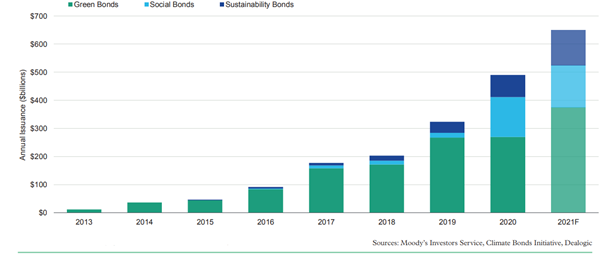
Source: Sustainable Bonds Insight 2021 - Environmental Finance, 2021
Fundamentally, ESG investing in fixed income makes plenty of sense. Governance is already a core aspect of fixed income analysis, and incorporating additional qualitative factors into credit analysis is beneficial. Furthermore, with global policy heading towards greater emphasis on ESG, they should continue to serve as guiding lights and provide a supportive global environment for more ESG assets.
However, in the present, rather than having a full ESG fixed income portfolio, we believe the optimal approach is to incorporate some ESG positive funds to supplement your current existing portfolio. We highlight some of these funds below, as well as compare their performance to that of our recommended funds.
Asia Bonds: Eastspring Investments – Asia Sustainable Bond Fund
For Asian bonds, we take a look at the Eastspring Investments – Asia Sustainable Bond Fund. The fund uses a top-down approach to identify opportunities in the Asian fixed income space, before applying an ESG overlay to determine which company to invest in. The ESG overlay is a two-part process - consisting of identifying key ESG issues and then determining whether a company is prepared to deal with them, which is used to determine if a company faces excessive ESG risk. The fund also invests in green bonds, with about 20% of its portfolio invested. However, portfolio yield targets, bond ratings and diversification remains the overriding priority for the fund, and the ESG analysis should be viewed as a complementary to these factors.
The fund has done quite well since its inception, and has outperformed both of the recommended funds on our platform. It has remained resilient despite the looming spectre of inflation and potential rate hikes ahead, likely due to its short duration and increased High Yield allocation vs its peers. Furthermore, perhaps due to its ESG overlay, the risk metrics look better than its peers despite its allocation to High Yield.
Chart 4: Eastspring Asia Sustainable Bond Funds vs Recommended Funds
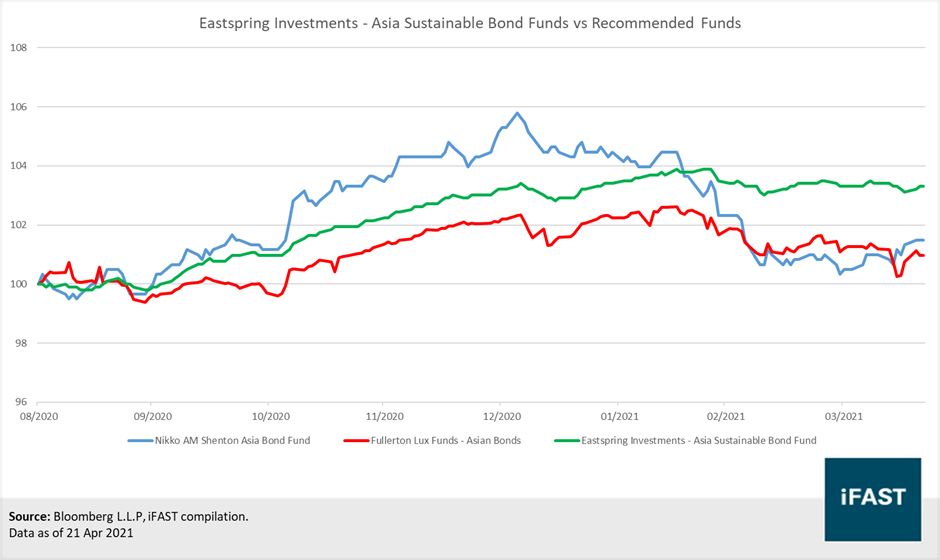
Note: 1Y Volatility used instead of 3Y due to the Eastspring fund’s inception date on 16th Dec 2019.
Despite the fund’s short history, the fund remains an attractive proposition, especially in a geographical segment that is still in the nascent stages of integrating ESG into fixed income investing.
Singapore Bonds: Pinebridge Singapore Bond Fund
Similarly to the aforementioned Eastspring Asia Sustainable Bond Fund, the Pinebridge Singapore Bond Fund incorporates ESG to complement traditional investment and credit selection processes despite not having ESG in its name. However, this fund strictly invests only in investment grade fixed income, and mainly focuses on capital preservation.
While the fund has slightly underperformed our recommended fund, it also has slightly better risk management characteristics, perhaps due to its ESG-centric investment processes.
Chart 5: Pinebridge Singapore Bond Fund vs Recommended Fund
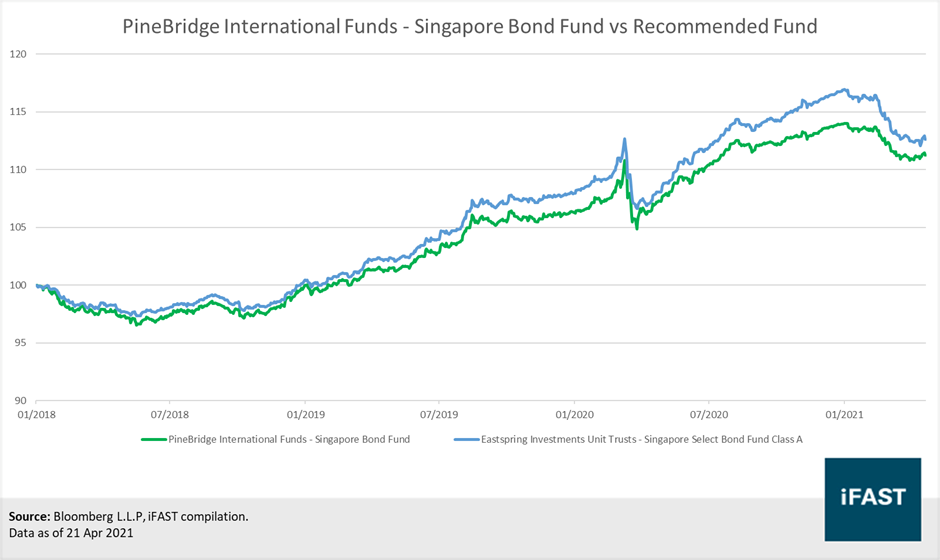

Generally, the fund exhibits very similar risk-return characteristics to its peer, and is certainly a viable choice for investors seeking to increase the ESG focus of their portfolio.
Global Bonds: Fidelity Sustainable Strategic Bond Fund
For investors who prefer to invest in global bonds, the Fidelity Sustainable Strategic Bond Fund stands out. Similar to the PineBridge Singapore Bond Fund, it focuses primarily on investment grade bonds, making it a good choice as part of a well balanced portfolio.
On a 3Y basis, the fund has a very similar return to another Fidelity fund, the Fidelity Global Bond fund. On the other hand, it has outperformed the other recommended fund, the Blackrock Fixed Income Global Opportunities Fund, quite significantly, due to its significantly better performance during the pandemic selloff in March 2020.
Compared to the Fidelity Global Bond fund, the fund has remained resilient in the recent spike in the 10Y Treasury Yields, while the former registered a ~5% drop. This is due to Fidelity Sustainable Strategic Bond Fund’s shorter duration profile, suggesting that there are increasingly more options when it comes to selecting ESG bond funds with shorter duration exposures that were previously unavailable.
Chart 6: Fidelity Sustainable Strategic Bond Fund vs Recommended Funds
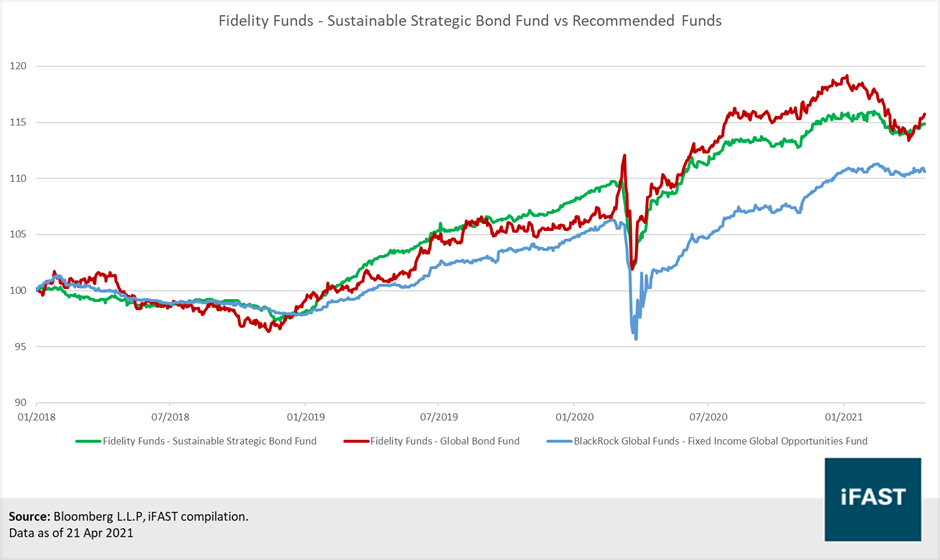

With similar returns and excellent risk management, the Fidelity Sustainable Strategic Bond Fund is definitely a viable choice as an ESG focused, quality focused fixed income fund.
Closing thoughts
Despite its recent growth, the ESG fixed income space still lags its equity counterpart in terms of size and importance. However, we have noticed the green shoots of change sprouting up, with further ESG bond issuance globally, as well as new funds to invest in these assets. We opted not to cover the Manulife Sustainable Asia Bond Fund and the JPM Global Bond Opportunities Sustainable Fund this time due to their short history, but they could be worth keeping an eye on moving forward.
In our next article, we will look to cover some ESG equity funds compare their performance against our recommended funds.
Footnotes:
1 - Sustainable Funds Outperform Peers in 2020 During Coronavirus - Morgan Stanley Institute of Sustainable Investing, 24 Feb 2021.
2 - Fixed Income has been slow to embrace ESG factors - CAMRADATA, 27 Aug 2020
Source:
Cheng Jingyan. (22 April 2021). Can investors build an ESG fixed income portfolio without sacrificing returns? Saving the world should not come at the expense of investment returns. FSMOne. https://secure.fundsupermart.com/fsm/article/view/rcms228080/can-investors-build-an-esg-fixed-income-portfolio-without-sacrificing-returns
Disclaimer
The information provided in this report is of a general nature and has been prepared for information purposes only. It is not intended to constitute research or as advice for any investor. The information in this report is not and should not be construed or considered as an offer, recommendation or solicitation for investments. Investors are advised to make their own independent evaluation of the information contained in this report, consider their own individual investment objectives, financial situation and particular needs and should seek appropriate personalised financial advice from a qualified professional to suit individual circumstances and risk profile.
The information contained in this report is prepared from data believed to be correct and reliable at the time of issuance of this report. While every effort is made to ensure the information is up-to-date and correct, Bond and Sukuk Information Platform Sdn Bhd (“the Company”) does not make any guarantee, representation or warranty, express or implied, as to the adequacy, accuracy, completeness, reliability or fairness of any such information contained in this report and accordingly, neither the Company nor any of its affiliates nor its related persons shall not be liable in any manner whatsoever for any consequences (including but not limited to any direct, indirect or consequential losses, loss of profits and damages) of any reliance thereon or usage thereof.
YOU MAY ALSO LIKE
ARTICLE
Dec 23, 2025
|
5 min read
ARTICLE
Sep 29, 2025
|
6 min read
ARTICLE
Aug 12, 2025
|
6 min read
ARTICLE
Jul 29, 2025
|
3 min read


